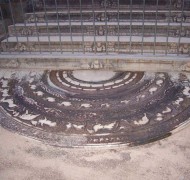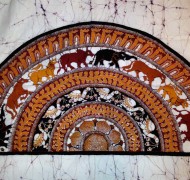These elaborately carved semi-circular stone slabs known as sandakada pahana or moonstones were usually placed at the bottom of staircases and entrances to Buddhist temples and shrines in Sri Lanka to serve as reminders of the Buddha’s teachings and symbols of the various stages we experience in samsara. The most ancient form from Anuradhapura consist of an outer ring of flames representing our worldly desires and passions followed by carvings of four animals (elephants, lions, horses, and bulls), following each other in procession symbolizing the four major stages in the life of the Buddha: birth (the elephant at Queen Maya’s conception–to a Buddhist, life begins at conception), sensual palatial life as a youth (the bull symbolizing desire), denouncement of palatial life (a horse was used to escape the palace), and enlightenment (the lion symbolizing the attainment of Nirvana–the famous lion’s roar proclaimed by the Buddha in both the Cula-sihanda Sutta and the Maha-sihanada Sutta). The next band was that of a tightly bound and intricate foilage garland known as liyavel, symbolizing our cravings, attachments and obscurations. This was followed by a procession of pious swans who are believed to be able to separate the curds from the whey when they drink milk, thus symbolizing the ability to separate good from evil that one learns on the path. As one develops one’s morality based on the Buddha’s teachings, one’s cravings become less and the next band of foliage is smaller, looser, and more beautiful to be followed by the lovely lotus in the center that symbolizes the eventual enlightenment to be obtained by following the teachings.
Anuradhapura, a UNESCO World Heritage Site and one of the oldest continuously occupied cities in the world, was the capital of Sri Lanka from about the fourth century BCE until the tenth century of the current era. Polonnaruwa, the capital from the tenth century until the thirteenth was heavily influenced by Hindu and other non-Buddhist interest so that the moonstone, while still featured, was modified to be more acceptable to the later rulers. Although the moonstone continued to be featured in the later capital of Kandy, it had been further modified and was devoid of much of its early Buddhist symbolism. The batik wall hanging shown here hangs in the entrance hall to the temple.


